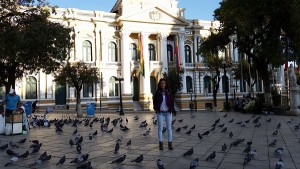 Nostra Signora di La Paz e' la città più alta del mondo a 3.600metri di altezza, ha l'aeroporto a 4100m. In pratica l'aereo atterra di corsa per compensare l'aria più rarefatta e i passeggeri appena arrivati soffrono di soroche (il mal d'altura). Anche noi ne abbiamo sofferto. I primi due giorni abbiamo dormito tanto e bevuto tanta acqua come consigliano di fare, limitando i movimenti come due bradipi.
Nostra Signora di La Paz e' la città più alta del mondo a 3.600metri di altezza, ha l'aeroporto a 4100m. In pratica l'aereo atterra di corsa per compensare l'aria più rarefatta e i passeggeri appena arrivati soffrono di soroche (il mal d'altura). Anche noi ne abbiamo sofferto. I primi due giorni abbiamo dormito tanto e bevuto tanta acqua come consigliano di fare, limitando i movimenti come due bradipi.
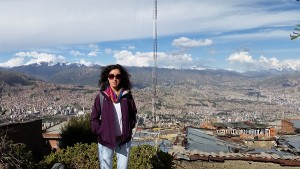 La città fa impressione nel senso buono del termine: prima di tutto il 90% delle case non sono finite, questo per evitare le tasse sulla casa (cosi dopo anni possono ancora dire “e' ancora in costruzione marescia'!”); secondo si sviluppa a mantello coprendo le onde morbide delle colline e delle montagne che la abitano.
Infatti nel lato est della citta' c'e' la Cordigliera Real (le Ande chiamate cosi dai boliviani) di cui il monte Illimani di 6400m di altezza ne e' il simbolo.
La città fa impressione nel senso buono del termine: prima di tutto il 90% delle case non sono finite, questo per evitare le tasse sulla casa (cosi dopo anni possono ancora dire “e' ancora in costruzione marescia'!”); secondo si sviluppa a mantello coprendo le onde morbide delle colline e delle montagne che la abitano.
Infatti nel lato est della citta' c'e' la Cordigliera Real (le Ande chiamate cosi dai boliviani) di cui il monte Illimani di 6400m di altezza ne e' il simbolo.
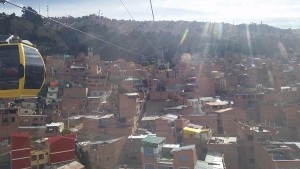 Una caratteristica di La Paz e' la teleferica (cabinovia): costituita da 6 linee, unisce e sposta da nord a sud e da su a giu turisti e locali, i quali si mettono in fila ordinati come per prendere un bus.
Noi ci abbiamo passato un pomeriggio facendo su e giu tra la linea gialla e verde, scendendo e risalendo come due bambini. Ovviamente tutto con immenso giubilo di Pietro che adora stare per aria e io con il pelo dritto come il gatto: odio rimanere penzoloni per aria in una scatoletta.
Una caratteristica di La Paz e' la teleferica (cabinovia): costituita da 6 linee, unisce e sposta da nord a sud e da su a giu turisti e locali, i quali si mettono in fila ordinati come per prendere un bus.
Noi ci abbiamo passato un pomeriggio facendo su e giu tra la linea gialla e verde, scendendo e risalendo come due bambini. Ovviamente tutto con immenso giubilo di Pietro che adora stare per aria e io con il pelo dritto come il gatto: odio rimanere penzoloni per aria in una scatoletta.
 Abbiamo beccato la domenica delle palme e le elezioni del sindaco quindi negozi chiusi, una marea di militari con pistole e fucili in giro e tanta gente per la strada con le palme pronti per la messa del pomeriggio. Noi ci siamo fatti una bella passeggiata pretendendo di aver superato il problema dell'altitudine.
Quindi km di camminata con il fiatone in giro per il centro per vedere piazza Murillo, considerata il centro citta' con la cattedrale e la casa del governo; la piazza di San Francesco con chiesa e museo; via linares famosa per i tanti ma tanti negozi con prodotti di alpaca e accessori vari (un vero paradiso del turista).
Una pare di questa via si chiama Mercato de las brujas (streghe) in quanto qui si vendono erbe ti tutti i tipi, misture medico-afrodisiache e cuccioli di llama morti.
Abbiamo beccato la domenica delle palme e le elezioni del sindaco quindi negozi chiusi, una marea di militari con pistole e fucili in giro e tanta gente per la strada con le palme pronti per la messa del pomeriggio. Noi ci siamo fatti una bella passeggiata pretendendo di aver superato il problema dell'altitudine.
Quindi km di camminata con il fiatone in giro per il centro per vedere piazza Murillo, considerata il centro citta' con la cattedrale e la casa del governo; la piazza di San Francesco con chiesa e museo; via linares famosa per i tanti ma tanti negozi con prodotti di alpaca e accessori vari (un vero paradiso del turista).
Una pare di questa via si chiama Mercato de las brujas (streghe) in quanto qui si vendono erbe ti tutti i tipi, misture medico-afrodisiache e cuccioli di llama morti. A quanto pare, quando si costruisce una casa o si apre un negozio la tradizione vuole che si seppellisca un cucciolo di llama morto per la buona sorte e per proteggersi dagli spiriti maligni, magari dicendo anche un padrenostro.. cosi per non sbagliare.
In tutta la Bolivia abbiamo incontrato questa mistura tra religione e credenze popolari: per esempio il culto del sole si avvicina all'adorazione religiosa per Dio o anche avere un mercato delle 'streghe' dietro la chiesa di san Francesco; e' una testimonianza che mito e tradizione sono parte integrante della giornata dei boliviani e che convivono armonicamente. Le persone quindi dopo essere andate in chiesa si dirigono al mercato per qualche pozione miracolosa o erba curativa, cercando un vaticino di qualche mammana per un futuro lavoro o prospero matrimonio.
Cibo:
Lo street food va per la maggiore, che vuol dire che cucinano di tutto per strada: dagli angoli alle piazze e' tutto un cuocere e friggere carne, pesce, patate, frittelle, pane con formaggio.
A quanto pare, quando si costruisce una casa o si apre un negozio la tradizione vuole che si seppellisca un cucciolo di llama morto per la buona sorte e per proteggersi dagli spiriti maligni, magari dicendo anche un padrenostro.. cosi per non sbagliare.
In tutta la Bolivia abbiamo incontrato questa mistura tra religione e credenze popolari: per esempio il culto del sole si avvicina all'adorazione religiosa per Dio o anche avere un mercato delle 'streghe' dietro la chiesa di san Francesco; e' una testimonianza che mito e tradizione sono parte integrante della giornata dei boliviani e che convivono armonicamente. Le persone quindi dopo essere andate in chiesa si dirigono al mercato per qualche pozione miracolosa o erba curativa, cercando un vaticino di qualche mammana per un futuro lavoro o prospero matrimonio.
Cibo:
Lo street food va per la maggiore, che vuol dire che cucinano di tutto per strada: dagli angoli alle piazze e' tutto un cuocere e friggere carne, pesce, patate, frittelle, pane con formaggio.
 Noi curiosi e golosi, pronti a sfidare la sorte a colpi di mal di pancia, abbiamo provato diverse cosette: prima di tutto le salteñas che non sono altro che delle empanadas locali con carne e verdure. Il segreto sta nel combinarle con la salsa giusta e non farne cadere nemmeno un pezzettino.
Un'altra cosa che mi ha fatto impazzire sono i buñuelos e i pastel serviti con api caldo. Sto parlando di una palla di pasta fritta molto leggera e sottile con un pezzetto di formaggio dentro, una bontá che se la batte con i pastel che sono delle semplici frittelle con uno sciroppetto dolce sopra. Questi vengono serviti con caffe, te di coca o normale, ma anche con una bevanda calda e dolce di mais, l'api appunto. Una cosa da diabete a cui non abbiamo saputo resistere... ripetutamente.
Hanno anche degli spiedini di carne di vitella sottile che viene cotta sulla griglia e bagnata con una salsetta profumata di un mix di erbe e olio (la realtá é che non abbiamo capito cosa sia), questo viene servito con patate piccole e gialle cotte sulla griglia anche loro. Si chiamano 'anticucho' e sono buonissimi.
C'e' anche la variante americana con salsicce tipo wustel tagliate a rondelle e fritte sulla piastra, accompagnate con patatine fritte tutto insudiciato di ketcup e mayo (salchipapa). Niente di tipico ma ne vanno tutti matti. Compreso Pietro.
Noi curiosi e golosi, pronti a sfidare la sorte a colpi di mal di pancia, abbiamo provato diverse cosette: prima di tutto le salteñas che non sono altro che delle empanadas locali con carne e verdure. Il segreto sta nel combinarle con la salsa giusta e non farne cadere nemmeno un pezzettino.
Un'altra cosa che mi ha fatto impazzire sono i buñuelos e i pastel serviti con api caldo. Sto parlando di una palla di pasta fritta molto leggera e sottile con un pezzetto di formaggio dentro, una bontá che se la batte con i pastel che sono delle semplici frittelle con uno sciroppetto dolce sopra. Questi vengono serviti con caffe, te di coca o normale, ma anche con una bevanda calda e dolce di mais, l'api appunto. Una cosa da diabete a cui non abbiamo saputo resistere... ripetutamente.
Hanno anche degli spiedini di carne di vitella sottile che viene cotta sulla griglia e bagnata con una salsetta profumata di un mix di erbe e olio (la realtá é che non abbiamo capito cosa sia), questo viene servito con patate piccole e gialle cotte sulla griglia anche loro. Si chiamano 'anticucho' e sono buonissimi.
C'e' anche la variante americana con salsicce tipo wustel tagliate a rondelle e fritte sulla piastra, accompagnate con patatine fritte tutto insudiciato di ketcup e mayo (salchipapa). Niente di tipico ma ne vanno tutti matti. Compreso Pietro.
Bolivia – La Paz
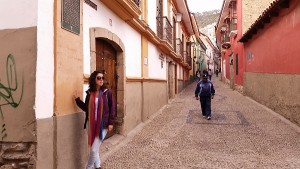 Nuestra Senora de La Paz is the highest city in the world with 3.600m height, it has the airport at 4100m. In practice, the plane lands speeding to compensate for the thinner air and the passengers, just arrived, suffer by soroche (altitude sickness). We have also suffered, in fact the first two days we slept a lot and drank much water as recommended, restricting the movements as two sloths.
The city is impressing, in a good sense of the term: first of all, 90% of houses are not finished, this is to avoid taxes on the house (so after years they can still say 'It is still under construction!'). It develops as a cloak covering the soft waves of the hills and mountains that inhabit it. In fact, in the east side of the city there is the Cordillera Real (the Andes so called by the Bolivian), of which Mount Illimani, 6400m of height, is its symbol.
A characteristic of La Paz is the cable car (teleferica): it consists of 6 lines, that allow people to move from north to south and from up to down; tourists and locals line up really tight as they were catching a bus. We spent an afternoon between the yellow and green lines, going up and down like two kids. Obviously with immense joy of Pietro, who loves being up in the air, and I with the hair straight like a cat: I hate remaining hanging in the air in a can.
Nuestra Senora de La Paz is the highest city in the world with 3.600m height, it has the airport at 4100m. In practice, the plane lands speeding to compensate for the thinner air and the passengers, just arrived, suffer by soroche (altitude sickness). We have also suffered, in fact the first two days we slept a lot and drank much water as recommended, restricting the movements as two sloths.
The city is impressing, in a good sense of the term: first of all, 90% of houses are not finished, this is to avoid taxes on the house (so after years they can still say 'It is still under construction!'). It develops as a cloak covering the soft waves of the hills and mountains that inhabit it. In fact, in the east side of the city there is the Cordillera Real (the Andes so called by the Bolivian), of which Mount Illimani, 6400m of height, is its symbol.
A characteristic of La Paz is the cable car (teleferica): it consists of 6 lines, that allow people to move from north to south and from up to down; tourists and locals line up really tight as they were catching a bus. We spent an afternoon between the yellow and green lines, going up and down like two kids. Obviously with immense joy of Pietro, who loves being up in the air, and I with the hair straight like a cat: I hate remaining hanging in the air in a can.

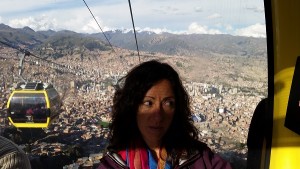 We caught the Palm Sunday and the election of the mayor, so all shops were closed, there was a flood of soldiers with guns and rifles around and many people in the street with palm trees ready for the afternoon mess. We went for a nice walk, pretending to have overcame the problem of the altitude.
We caught the Palm Sunday and the election of the mayor, so all shops were closed, there was a flood of soldiers with guns and rifles around and many people in the street with palm trees ready for the afternoon mess. We went for a nice walk, pretending to have overcame the problem of the altitude.
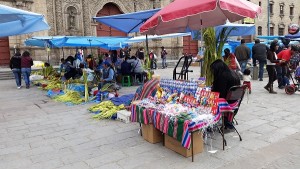 So we walked km, out of breath, around the center to see Murillo Square, considered the center of the city with the cathedral and the house of the government; San Francesco Square with the church and the museum; linares street famous for many, many shops with alpaca products and various accessories (a paradise for tourists).
There is a block on this street called Mercado de las brujas (witches market) because here they sell you all kinds herbs, medical-aphrodisiac mixtures and baby llama fetuces. Apparently, when you build a house or open a shop the tradition is to bury a died baby llama for good luck and to protect from evil spirits, saying maybe even an Our Father pray .. just to not be wrong.
So we walked km, out of breath, around the center to see Murillo Square, considered the center of the city with the cathedral and the house of the government; San Francesco Square with the church and the museum; linares street famous for many, many shops with alpaca products and various accessories (a paradise for tourists).
There is a block on this street called Mercado de las brujas (witches market) because here they sell you all kinds herbs, medical-aphrodisiac mixtures and baby llama fetuces. Apparently, when you build a house or open a shop the tradition is to bury a died baby llama for good luck and to protect from evil spirits, saying maybe even an Our Father pray .. just to not be wrong.
 Throughout Bolivia we met this mixture between religion and popular beliefs: for example, the worship of the sun is really similar to the religious worship to Cristian God, or even having a market of 'witches' behind the church of St. Francis is a testimony that myth and tradition are an integral part of the dayly life of Bolivians.
People after going to church, head to the market for some miraculous potions or healing herbs, trying for a witches' prophecy for a prosperous work or marriage.
Food:
Throughout Bolivia we met this mixture between religion and popular beliefs: for example, the worship of the sun is really similar to the religious worship to Cristian God, or even having a market of 'witches' behind the church of St. Francis is a testimony that myth and tradition are an integral part of the dayly life of Bolivians.
People after going to church, head to the market for some miraculous potions or healing herbs, trying for a witches' prophecy for a prosperous work or marriage.
Food:
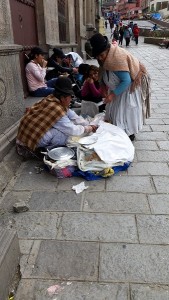 The street food is the most popular, which means that they cook everything on the street: in every corner and square there is a woman cooking or frying meat, fish, potatoes, pancakes or bread with cheese.
We, curious and greedy, ready to test your luck challenging our stomach (ache), tried different little things: first of all the salteñas that are nothing more than the local empanadas with meat and vegetables.
The secret is to combine them with the right sauce and not drop even a little bit on the floor.
Another thing that made me mad is the buñuelo and pastel, served with api. I'm talking about a ball of fried dough very light and thin with a piece of cheese inside, a delight that competes with pastel.
Those are simple fried pancakes served with a sweet syrup on top. These are served with coffee, coca or normal tea, but also with a hot drink of sweet corn, the 'api' precisely. One super yummi, diabetes-wanting delight to which we could not resist ... repeatedly.
The street food is the most popular, which means that they cook everything on the street: in every corner and square there is a woman cooking or frying meat, fish, potatoes, pancakes or bread with cheese.
We, curious and greedy, ready to test your luck challenging our stomach (ache), tried different little things: first of all the salteñas that are nothing more than the local empanadas with meat and vegetables.
The secret is to combine them with the right sauce and not drop even a little bit on the floor.
Another thing that made me mad is the buñuelo and pastel, served with api. I'm talking about a ball of fried dough very light and thin with a piece of cheese inside, a delight that competes with pastel.
Those are simple fried pancakes served with a sweet syrup on top. These are served with coffee, coca or normal tea, but also with a hot drink of sweet corn, the 'api' precisely. One super yummi, diabetes-wanting delight to which we could not resist ... repeatedly.
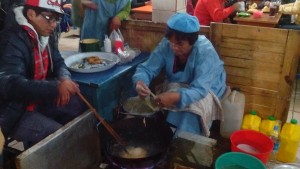
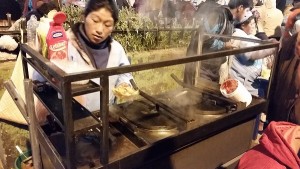
 They also have the meat skewers of thin-cut veal, cooked on the grill. These are constantly wet with a sauce of herbs' mix and oil (the reality is that we did not understand what it was), this is served with small and yellow potatoes, cooked on the grill they too.
They are called 'anticucho' and they are simply delicious.
There is also an American variant with a sliced and fried hot dog, accompanied with chips all soiled with ketchup and mayo (salchipapa).
Nothing typical but they all go crazy for that, including Pietro.
They also have the meat skewers of thin-cut veal, cooked on the grill. These are constantly wet with a sauce of herbs' mix and oil (the reality is that we did not understand what it was), this is served with small and yellow potatoes, cooked on the grill they too.
They are called 'anticucho' and they are simply delicious.
There is also an American variant with a sliced and fried hot dog, accompanied with chips all soiled with ketchup and mayo (salchipapa).
Nothing typical but they all go crazy for that, including Pietro. 